Centermark
| Toolbar | Menu |
|---|---|
|
|
|
Dimension commands create dimensions that annotate length, angle, radius, etc. parallel to the active CPlane. Dimensions are attached to the object by History.
The Centermark command draws a cross or a cross and center lines at the center point of a curve.
The size and style of the centermark are controlled by the Annotation style and the Centermark properties.
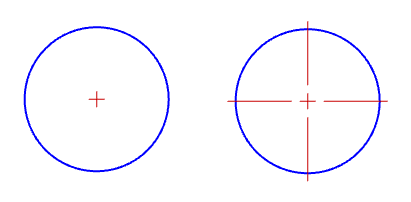
Sets the style of the centermark for radius and diameter dimensions
No centermark is drawn.

A cross mark is drawn at the center of the radius or diameter.
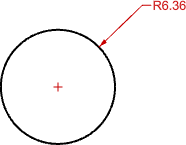
A cross mark and lines that extend to just beyond the edges of the object.
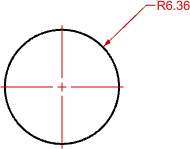
| Toolbar | Menu |
|---|---|
|
|
Dimension Linear Dimension |
The Dim command draws horizontal or vertical linear dimensions.
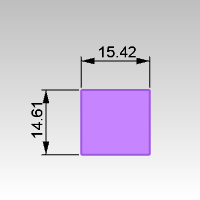
Pick the third point to locate the dimension line.
When the dimension text does not fit between the extension lines, you can place the dimension text on left or right.
| Command-line options | |
|---|---|
|
Style |
Select the annotation style name. |
|
Object |
Select an object to dimension. |
|
Add more (chain) dimensions along the same dimension line. |
|
|
Undo |
Reverses the last action. |
|
Baseline |
Continues dimensioning from the first point.
|
|
Draws the dimension aligned with the construction plane y axis. |
|
|
Draws the dimension aligned with the construction plane x axis. |
|
Dimensions apply settings from annotation styles. If you need a dimension to look different than its annotation style, you can override settings in the dimension properties.
Or
The settings different from the annotation style will be highlighted in blue.
| Toolbar | Menu |
|---|---|
|
|
Dimension Aligned Dimension |
The DimAligned command draws a linear dimension lined up with two points.

Pick the third point to locate the dimension line.
When the dimension text does not fit between the extension lines, you can place the dimension text on left or right.
| Command-line options | |
|---|---|
|
Style |
Select the annotation style name. |
|
Object |
Select an object to dimension. |
|
Continue |
Add more (chain) dimensions along the same dimension line. |
|
Baseline |
Continues dimensioning from the first point.
|
|
Undo |
Reverses the last action. |
Dimensions apply settings from annotation styles. If you need a dimension to look different than its annotation style, you can override settings in the dimension properties.
Or
The settings different from the annotation style will be highlighted in blue.
| Toolbar | Menu |
|---|---|
|
|
Dimension Angle Dimension |
The DimAngle command dimensions the angle of an arc, or between two selected lines, or from three points.
| Command-line options | |
|---|---|
|
Style |
Select the annotation style name. |
|
Points |
Pick the apex of the angle (1) and then the dimension points (2) and (3). |
Dimensions apply settings from annotation styles. If you need a dimension to look different than its annotation style, you can override settings in the dimension properties.
Or
The settings different from the annotation style will be highlighted in blue.
| Toolbar | Menu |
|---|---|
|
|
Dimension Area Dimension |
The DimArea command dimensions the area of closed planar curves, surfaces, polysurfaces, meshes, or hatches.

| Command-line option | |
|---|---|
|
Style |
LeaderUses a leader to point to the object. TextPlaces the text at the picked location. The dimension uses a text field for calculating the dimension. |
Or
| Toolbar | Menu |
|---|---|
|
|
Dimension Curve Length Dimension |
The DimCurveLength command dimensions the length of a curve.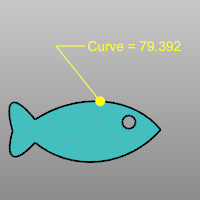
| Command-line option | |
|---|---|
|
Style |
LeaderUses a leader to point to the object. TextPlaces the text at the picked location. The dimension uses a text field for calculating the dimension. |
Or
| Toolbar | Menu |
|---|---|
|
|
Dimension Crease Angle Dimension |
The DimCreaseAngle command dimensions the angle between two planes.
Dimensions apply settings from annotation styles. If you need a dimension to look different than its annotation style, you can override settings in the dimension properties.
Or
The settings different from the annotation style will be highlighted in blue.
| Toolbar | Menu |
|---|---|
|
|
Dimension Diameter Dimension |
The DimDiameter command dimensions the diameter of a selected curve.
| Command-line option | |
|---|---|
|
Style |
Select the annotation style name. |
Dimensions apply settings from annotation styles. If you need a dimension to look different than its annotation style, you can override settings in the dimension properties.
Or
The settings different from the annotation style will be highlighted in blue.
| Toolbar | Menu |
|---|---|
|
|
Dimension Ordinate Dimension |
The DimOrdinate command dimensions the x or y distance from a base location.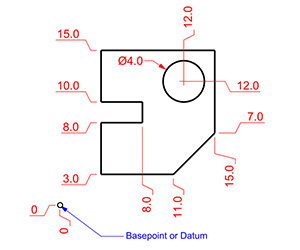
The shape of the ordinate leader can be point edited after creation to avoid overlapping geometry.
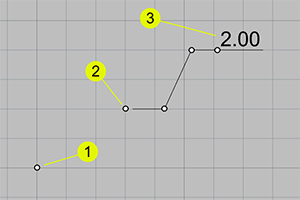
| Command-line options | |
|---|---|
|
AnnotationStyle |
Select the annotation style name. |
|
XDatum |
Overrides the implied biasing and forces an X ordinate dimension. |
|
YDatum |
Overrides the implied biasing and forces a Y ordinate dimension. |
|
Basepoint |
Changes the basepoint for the duration of the command. The basepoint reverts to the default construction plane origin when the DimOrdinate command is run again. |
| KinkOffset |
Decides the offset distance of the two kinks (1) (2) before the leader endpoint (3). This option appears after the first point is picked. 
|
Dimensions apply settings from annotation styles. If you need a dimension to look different than its annotation style, you can override settings in the dimension properties.
Or
The settings different from the annotation style will be highlighted in blue.
| Toolbar | Menu |
|---|---|
|
|
Dimension Radial Dimension |
The DimRadius command dimensions the radius of an arc or circle.
Dimensions always measure as though the object were projected to the current construction plane.
| Command-line options | |
|---|---|
|
Style |
Select the annotation style name. |
|
PointOnCurve |
Pick a point on the curve where the dimension arrow will start. |
Dimensions apply settings from annotation styles. If you need a dimension to look different than its annotation style, you can override settings in the dimension properties.
Or
The settings different from the annotation style will be highlighted in blue.
| Toolbar | Menu |
|---|---|
|
|
Dimension Rotated Dimension |
The DimRotated command draws a linear dimension that is rotated from the xy axis.
| Command-line options | |
|---|---|
|
Style |
Select the annotation style name. |
|
Object |
Select an object to dimension. |
|
Continue |
Add more (chain) dimensions along the same dimension line. |
|
Baseline |
Continues dimensioning from the first point.
|
Dimensions apply settings from annotation styles. If you need a dimension to look different than its annotation style, you can override settings in the dimension properties.
Or
The settings different from the annotation style will be highlighted in blue.
| Toolbar | Menu |
|---|---|
|
|
Dimension Recenter Dimension Text |
The DimRecenterText command returns dimension text to its default location.
The used annotation style.
Lists the annotation styles available in the model. If an annotation has any settings in its properties different from its style, a menu behind the style name appears.
Resets all the changed settings to the style defaults.
Applies the changed settings to the annotation style.
Uses the settings in the properties to create a new style.
Edits the Annotations style used by the selected annotation object.
The text height.
Surrounds text with an opaque color.
Turn off mask.
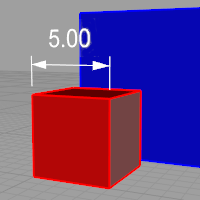
Sets the mask color to the viewport background color.
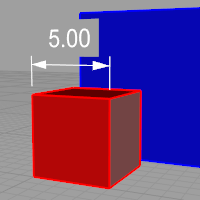
Selects the mask color using the Select Color dialog box.
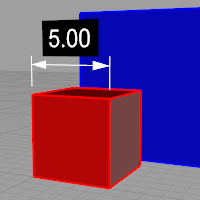
When Mask is set to Solid Color, click to change the color.
The width of the blank area around the text.
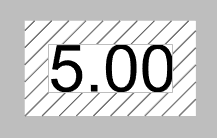
The display size is a product of the component's size (like arrow size or text height) and the Model space scale value.
Normally this is the inverse of the print scale. The text height, extension line extension, extension line offset distance, and arrow length are multiplied by this number.
The text appearance.
Click to open the drop-down list, and type the initial letter of a font to find the font quickly.
Click the font control twice and scroll the mouse wheel to select a font with preview.
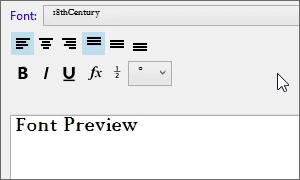
If a font used by an annotation is missing on the current system:
You will be prompted when you select the annotation or edit the style.
The annotation displays with a substitute font in viewports.
The missing font is listed with "(not installed)" in the font list.
Sets the font style to bold.
Sets the font style to italic.
Sets the font style to underlined.
Text fields are formulas that are evaluated while Rhino is running and the result is displayed in the text. All text fields are in the syntax of %<field and options>%. When a formula cannot be evaluated an error string of #### is displayed.
Note
The toggle stacking brackets button is a shortcut to add or remove [[...]] around text selected in the edit box. Stacking brackets will make the text between them stack, so that [[1/2]] will display as a stacked fraction.
Enters a degree symbol (°) into the text.
Enters a radius symbol (R) into the text.
Enters a diameter symbol (Ø) into the text.
Enters a plus/minus symbol (±) into the text.
The angle brackets < > represent the dimension value. You can type additional text before or after the angle brackets, or you can eliminate the angle brackets.
To type multi-line text, press and hold Alt and press Enter.
The current dimension value.
Edits the Annotations style used by the selected annotation object.
Select an annotation to apply its properties to the current annotation.
Automatically determines where to place the text.
Forces the text to the inside of the dimension lines.

Forces the text to the outside and to the right of the dimension lines.

Forces the text to the outside and to the left of the dimension lines.

HintLeft and HintRight are automatically selected based on where you pick to place the dimension line. Picking on the left, HintLeft is selected. Picking on the right, HintRight is selected. When the dimension is changed, and the dimension text no longer fits between the extension lines, the dimension text will be moved to the left or right side.
|
|
|
|
HintLeft
|
HintRight
|
 Arrow
Arrow  Dot
Dot  Tick
Tick  Short arrow
Short arrow  Open arrow
Open arrow  Rectangle
Rectangle  Thin arrow
Thin arrow  Thinner arrow
Thinner arrow Uses a previously defined block as an arrowhead.
This option is not available when no blocks exist in the model.

The base point of the arrowhead block determines how the arrowhead is placed on the end of a dimension line or a leader. In the illustration below:
(1) The base point of the arrowhead block is placed at the tip of the arrowhead curve. The dimension line passes the arrowhead.
(2) The base point of the arrowhead block is placed at the end of the arrowhead curve. The dimension line does not pass the arrowhead.
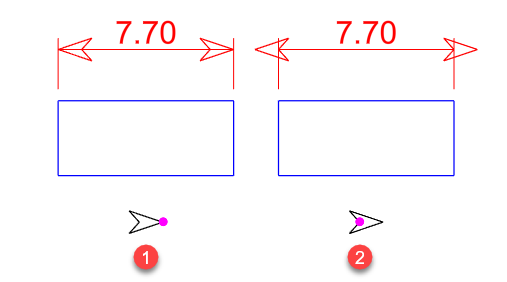
If you want the tip of the arrowhead to be accurately placed at a location, be sure to place the base point of the arrowhead block at the tip.
No arrow is drawn.

The length of the arrowhead from tip to tail.
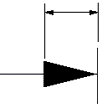
When there is not enough space for the arrows, you can force their position.
Automatically determines where to place the arrows.
Forces the arrows to the inside of the dimension lines.

Forces the arrows to the outside of the dimension lines.

Force drawing the dimension line when the arrows are on the outside.
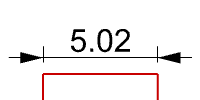
The unit and format of the annotation style.
Distances in dimensions are multiplied by this value.
The number of decimal places for the distance display.
Rounds off the dimension to the nearest listed value.
Text added before and after the dimension text.
Prefix and suffix only display when the dimension text string contains "<>".
Turns off the display of zeros at the beginning or end of the dimension.
0.560
.560
0.56
.56
 Use alternate units
Use alternate unitsDisplays the second units in linear dimensions.
The unit and format of the annotation style.
Distances in dimensions are multiplied by this value.
The number of decimal places for the distance display.
Rounds off the dimension to the nearest listed value.
Text added before and after the dimension text.
Prefix and suffix only display when the dimension text string contains "<>".
Turns off the display of zeros at the beginning or end of the dimension.
0.560
.560
0.56
.56
 Alternate units below
Alternate units belowDisplays alternate units on the other side of the dimensions lines.
Controls how the tolerance is formatted or displayed on the dimension line.
No tolerance is added.
Adds a ± (plus/minus) character and single Upper value.

Displays the Upper value preceded by a + (plus) character and the Lower value preceded by a - (minus) character on the dimension line. Entering a negative number reverses the tolerance display from positive to negative and negative to positive.

Displays the dimension length plus the Upper value and the dimension length minus the Lower value.

Specifies the number of decimal places for the tolerance value.
Specifies the number of decimal places for the tolerance value in the alternate units.
Specifies the maximum or upper tolerance value.
Specifies the minimum or lower tolerance value.
Specifies the relative text height for the tolerance values. This setting is only for stacked types of tolerances.

See: Annotation: Arrows
See: Annotation: Leaders
How to use SmartTrack to place the dimension
Use text and dimensions for annotation
Rhinoceros 6 © 2010-2020 Robert McNeel & Associates. 11-Nov-2020